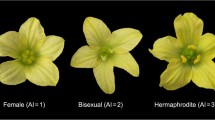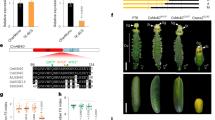Abstract
External treatment with ethylene had indicated earlier that this hormone is the main factor controlling sex determination in Cucurbita pepo. Up to now, however, there was no genetic evidence that supported the relationship between ethylene production, or perception, and sexual expression in this species. Here we demonstrate that the extreme male phenotype of the Vegetable Spaghetti (Veg) inbred line of C. pepo subspecies pepo is determined by a major gene that confers reduced ethylene sensitivity in plants. The production of female flowers in the Veg line is very delayed and reduced with respect to the contrasting Bolognese (Bog) line, ranging between 5 and 35% of female flowers per plant. This enhanced maleness trait segregates as a single gene in the F2 and backcross (BC) generations, and co-segregates with a weak ethylene-insensitive phenotype in the F2 population, suggesting that the gene responsible for the Veg phenotype could be the result of a mutation in a receptor or response gene for ethylene. Although the etiolated seedlings of the Veg line, and the most androecious plants in the F2 generation, produce more ethylene than those of the contrasting line, they are less sensitive to this hormone, as indicated by a weaker triple response and a delayed abscission of ethylene-treated male flowers. Given that the sexual phenotype of F2 plants is correlated with ethylene sensitivity, with the more sensitive plants producing the higher number of female flowers, our results demonstrate that the ethylene response is directly involved in the control of sex determination in C. pepo. It regulates the induction of female flower production, and therefore the extension of the initial phase of development in which the plant produces only male flowers, as well as the number of female flowers per plant.





Similar content being viewed by others
References
Alonso JM, Stepanova AN, Solano R, Wisman E, Ferrari S, Ausubel FM, Ecker JR (2003) Five components of the ethylene-response pathway identified in a screen for weak ethylene-insensitive mutants in Arabidopsis. Proc Natl Acad Sci USA 100:2992–2997
Boualem A, Fergany M, Fernandez R, Troadec C, Martin A, Morin H, Sari M, Collin F, Flowers JM, Pitrat M, Purugganan MD, Dogimont C, Bendahmane A (2008) A conserved mutation in an ethylene biosynthesis enzyme leads to andromonoecy in melons. Science 321:836–838
Byers RE, Baker LR, Sell HM, Herner RC, Dilley DR (1972) Ethylene: a natural regulator of sex expression in Cucumis melo L. Proc Natl Acad Sci USA 69:712–720
Clark DG, Gubrium EK, Barrett JE, Nell TA, Klee HJ (1999) Root formation in ethylene-insensitive plants. Plant Physiol 121:53–59
DenNijs APM, Visser DL (1980) Induction of male flowering in gynoecious cucumbers (Cucumis sativus L.) by silver ions. Euphytica 29:273–280
Duan Q, Wang D, Xu Z, Bai S (2008) Stamen development in Arabidopsis is arrested by organ-specific overexpression of a cucumber ethylene synthesis gene CsACO2. Planta 228:537–543
Galun E (1961) Study of the inheritance of sex expression in the cucumber: the interaction of major genes with modifying genetic and non-genetic factors. Genetica 32:134–163
Guo H, Ecker JR (2003) Plant responses to ethylene gas are mediated by SCFEBF1/EBF2-dependent proteolysis of EIN3 transcription factor. Cell 115:667–677
Hibi T, Kosugi S, Iwai T, Kawata M, Seo S, Mitsuhara I, Ohashi Y (2007) Involvement of EIN3 homologues in basic PR gene expression and flower development in tobacco plants. J Exp Bot 58:3671–3678
Kamachi S, Sekimoto H, Kondo N, Sakai S (1997) Cloning of a cDNA for a 1-aminocyclopropane-1-carboxylate synthase that is expressed during development of female flowers at the apices of Cucumis sativus L. Plant Cell Physiol 38:1197–1206
Kenigsbuch D, Cohen Y (1990) The inheritance of gynoecy in muskmelon. Genome 33:317–320
Knopf RR, Trebitsh T (2006) The female-specific Cs-ACS1G gene of cucumber. A case of gene duplication and recombination between the non-sex-specific 1-aminocyclopropane-1-carboxylate synthase gene and a branched-chain amino acid transaminase gene. Plant Cell Physiol 47:1217–1228
Kubicki B (1969) Investigation of sex determination in cucumber (Cucumis sativus L.). Genet Pol 10:101–121
Little HA, Papadopoulou E, Hammar SA, Grumet R (2007) The influence of ethylene perception on sex expression in melon (Cucumis melo L.) as assessed by expression of the mutant ethylene receptor, At-etr1-1, under the control of constitutive and floral targeted promoters. Sex Plant Reprod 20:123–136
Liu S, Xu L, Jia Z, Xu Y, Yang Q, Fei Z, Lu X, Chen H, Huang S (2008) Genetic association of ETHYLENE-INSENSITIVE3-like sequence with the sex-determining M locus in cucumber (Cucumis sativus L.). Theor Appl Genet 117:927–933
Manzano S, Martínez C, Kraakman P, Jamilena M (2008) Use of ethylene production as a marker for the selection of gynoecy in melon (Cucumis melo). In: Pitrat M (ed) Cucurbitaceae 2008, IXth EUCARPIA meeting on genetics and breeding of Cucurbitaceae. INRA, Avignon, France, pp 557–561
Matlob AN, Basher EA (1983) The effect of growth regulators on sex expression and yield of summer squash (Cucurbita pepo L). Acta Hortic (ISHS) 137:361–366
Mibus H, Tatlioglu T (2004) Molecular characterization and isolation of the F/f gene for femaleness in cucumber (Cucumis sativus L.). Theor Appl Genet 109:1669–1676
Owens KW, Peterson CE, Tolla GE (1980) Production of hermaphrodite flowers on gynoecious muskmelon by silver nitrate and aminoethyoxyvinylglycine. HortScience 15:654–655
Papadopoulou E, Little HA, Hammar SA, Grumet R (2005) Effect of modified endogenous ethylene production on sex expression, bisexual flower development and fruit production in melon (Cucumis melo L.). Sex Plant Reprod 18:131–142
Payán MC, Peñaranda A, Rosales R, Garrido D, Gómez P, Jamilena M (2006) Ethylene mediates the induction of fruits with attached flower in zucchini squash. In: Holmes GJ (ed), Proceedings of Cucurbitaceae 2006. Universal Press, Raleigh, NC, pp 171-179
Peñaranda A, Payán MC, Garrido D, Gómez P, Jamilena M (2007) Production of fruits with attached flowers in zucchini squash is correlated with the arrest of maturation of female flowers. J Hort Sci Biotechnol 82:579–584
Perl-Treves R (1999) Male to female conversion along the cucumber shoot: approaches to studying sex genes and floral development in Cucumis sativus. In: Ainsworth CC (ed) Sex determination in plants. BIOS Scientific Publisher, Oxford, UK, pp 189–216
Pierce LK, Wehner TC (1990) Review of genes and linkage groups in cucumber. HortScience 25:605–615
Rudich J (1990) Biochemical aspects of hormonal regulation of sex expression in cucurbits. In: Bates DM, Robinson RW, Jeffrey C (eds) Biology and utilization of the Cucurbitaceae. Cornell University Press, Ithaca, NY, pp 269–280
Rudich J, Halevy AH, Kedar N (1969) Increase in femaleness of three cucurbits by treatment with Ethrel, an ethylene releasing compound. Planta 86:69–76
Rudich J, Halevy AH, Kedar N (1972) Ethylene evolution from cucumber plants as related to sex expression. Plant Physiol 49:998–999
Stepanova AN, Alonso JM (2005) Arabidopsis ethylene signalling pathway: a unique signaling cascade with a multitude of inputs and outputs. Physiol Plant 123:195–206
Stepanova AN, Hoyt JM, Hamilton AA, Alonso JM (2005) A link between ethylene and auxin uncovered by the characterization of two root-specific ethylene-insensitive mutants in Arabidopsis. Plant Cell 17:2230–2242
Stepanova AN, Robertson-Hoyt J, Yun J, Benavente LM, D- Xie, Doležal K, Schlereth A, Jürgens G, Alonso JM (2008) TAA1-mediated auxin biosynthesis is essential for hormone crosstalk and plant development. Cell 133:177–191
Takada K, Ishimaru K, Minamisawa K, Kamada H, Ezura H (2005) Expression of a mutated melon ethylene receptor gene Cm-ETR1/H69A affects stamen development in Nicotiana tabacum. Plant Sci 169:935–942
Takada K, Ishimaru K, Kamada H, Ezura H (2006) Anther-specific expression of mutated melon ethylene receptor gene Cm-ERS1/H70A affected tapetum degeneration and pollen grain production in transgenic tobacco plants. Plant Cell Rep 25:936–941
Takahashi H, Jaffe MJ (1984) Further studies of auxin and ACC induced feminization in the cucumber plant using ethylene inhibitors. Phyton 44:81–86
Trebitsh T, Rudich J, Riov J (1987) Auxin, biosynthesis of ethylene and sex expression in cucumber (Cucumis sativus). J Plant Growth Regul 5:105–113
Trebitsh T, Staub JE, O’Neill SD (1997) Identification of a 1-aminocyclopropane-1-carboxylic acid synthase gene linked to the female (F) locus that enhances female sex expression in cucumber. Plant Physiol 113:987–995
Wien HC (1997) The cucurbits: cucumber, melon, squash and pumpkin. In: Wien HC (ed) The physiology of vegetable crops. CAB International, New York, pp 345–386
Wien HC, Stapleton SC, Maynard DN, McClurg C, Riggs D (2004) Flowering, sex expression, and fruiting of pumpkin (Cucurbita sp.) cultivars under various temperatures in greenhouse and distant field trials. HortScience 39:239–242
Wilkinson JQ, Lanahan MB, Clark DG, Bleecker AB, Chang G, Meyerowitz EM, Klee HJ (1997) A dominant mutant receptor from Arabidopsis confers ethylene insensitivity in heterologous plants. Nat Biotechnol 15:444–447
Yamasaki S, Fujii N, Matsuura S, Mizusawa H, Takahashi H (2001) The M locus and ethylene-controlled sex determination in andromonoecious cucumber plants. Plant Cell Physiol 42:608–619
Acknowledgments
We are indebted to Dr. Harry S. Paris, Department of Vegetable Crops and Plant Genetics, Newe Ya’ar Research Center (Israel), who kindly provided seeds for the inbred lines used in this study. This work was supported by grants AGL2005-06677-CO2 and AGL2008-05619-C02-02/ALI awarded by the Ministerio de Ciencia e Innovación (Spain) and by grant CVI-02617 awarded by the Consejería de Innovación, Ciencia y Empresa (Junta de Andalucía, Spain).
Author information
Authors and Affiliations
Corresponding author
Rights and permissions
About this article
Cite this article
Manzano, S., Martínez, C., Domínguez, V. et al. A Major Gene Conferring Reduced Ethylene Sensitivity and Maleness in Cucurbita pepo . J Plant Growth Regul 29, 73–80 (2010). https://doi.org/10.1007/s00344-009-9116-5
Received:
Accepted:
Published:
Issue Date:
DOI: https://doi.org/10.1007/s00344-009-9116-5




